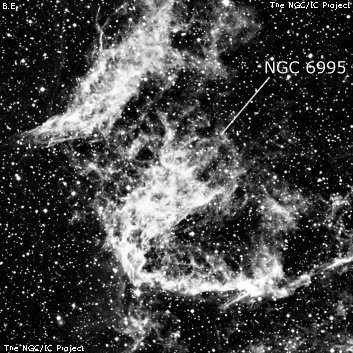
John Herschel discovered NGC 6995 = h2093 on 7 Sep 1825 (sweep 8) and recorded "A most wonderful phenomenon. A very large space 20' or 30' broad in PD and 1m or 2m in RA, full of nebula and stars mixed. The nebula is decidedly attached to the stars and is as decidedly not stellar. It forms irregular lace-work marked out by stars, but some parts decidedly nebulous, wherein no stars can be seen. A figure (from which the drawing for the engraving was copied), represents the general character, but not the minute details of this objects, which would be extremely difficult to give with any degree of fidelity." Ebenezer Mason was first to point out the Herschel's position was exactly 1° too far south based on Mason's careful observations and sketch (around 1838). Herschel's description and sketch clearly refer to the southern portion of the eastern half of the Veil Nebula. The northern half carries the number NGC 6992. This was only John Herschel's 6th overall discovery!
300/350mm - 13.1" (7/5/86): this is the amazingly detailed southern end of the eastern section of the Veil Nebula attached to NGC 6992 and contains beautiful feather-like side branches to the west, especially using an OIII filter. See description of NGC 6992.
400/500mm - 17.5" (7/5/86): feather-like side branches on the south end run off towards the west. Using an OIII filter at 83x, the breathtaking filamentary detail is too detailed to fully describe but the filaments appear like intertwined threads or twisted ropes giving a striking 3-dimensional appearance!
Notes by Steve Gottlieb